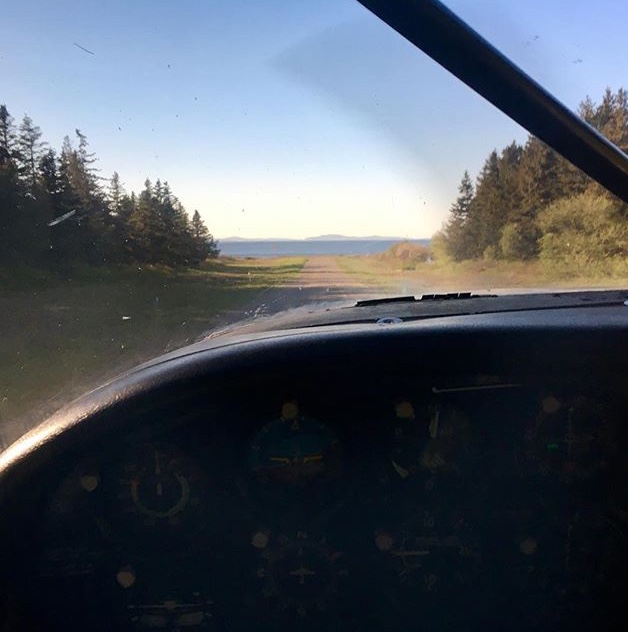
Looking to the north and back towards the mainland at Matinicus’s airstrip
With the wind aggressively buffeting the plane, I sit here in the pilot’s seat contemplating my choices in life as I taxi the heavy Cessna 206 down the dirt/gravel airstrip on Matinicus. The end of the runway, where it meets the sea, is just ahead and it is where I will turn around and takeoff uphill towards trees and the barn…but more importantly–into the wind. To be more precise about my wandering mind, I’m contemplating my immediate decision to take off uphill and over the obstacles in this heavy plane; but with the strong, gusty southwesterly wind this is undoubtedly the better choice in my humble opinion. As I glance around the full airplane I can see all of my passengers are lost in their thoughts also. Being year round inhabitants of this tiny island community they are seasoned passengers and this is something they do all the time knowing we pilots will do everything within our power to make their flight as safe as possible.
Matinicus is an island approximately seventeen miles off the coast of Maine in the Atlantic Ocean. Affectionately known as “Mat” to those of us that work in our small charter outfit, it is not a large island and measures two miles in length by one mile in width. It is said to be the furthest offshore island on the east coast that is inhabited year round and is served by a thriving fishing community, schoolhouse, post office, airstrip and church; in addition to the homes of its relatively few inhabitants.
At somewhere just shy of 1,700 feet (1,668.5 feet to be exact) the airstrip is quite long compared to some of our strips on other islands, but Mat has its quirks as most of our airstrips do; there is a significant hill to take into consideration when landing and taking off which is very important given that often our planes are heavily loaded when arriving and departing. More importantly there are the persistent crosswinds to consider, Matinicus is known for some hellacious winds which like to blow directly across the strip–and the passengers know these can make for some interesting landings. Given that Mat is an island, the wind can really get to blowing out here and with nothing to slow it down a pilot trying to land can really be in for an interesting ride trying to get the craft safely on the ground. I would be remiss if I did not mention the notorious barn at the south end of the runway. Taking off uphill (or landing downhill for that matter) there is a barn to contend with…it has a way of looking like it’s going to reach up and snag the planes landing gear as we pass by because often times we barely clear it! To a pilot unaccustomed to flying into this strip the barn can be an intimidating structure ready to strike the fragile plane from the sky…but after a few times you learn there are more important risks to consider, and the barn becomes a nonissue most days.
With the tough old Cessna heavily loaded I obviously prefer to depart downhill to the north because as you can see in the accompanying photo there are no obstructions at the end of the strip, nor are there any obstructions all the way to the mainland for that matter. I’ve often said as long as I could clear the foot high berm at the end of the runway I could fly all the way back to our home base at Owls Head in ground effect–within feet of sea level! One of our pilots jokingly says he prefers to have the tide out because it buys him another fifteen or more feet of clearance…enough to take another lucky passenger when weight is a factor!
Either way, the time has come to focus on what I’m getting paid to do, and the plane is turned around facing uphill towards the barn. I smoothly but forcefully push the throttle fully in giving us the maximum power available and the best possible chance of a successful take off. The plane accelerates nicely but noticeably slower than when she is not weighted down so heavily. Regardless the plane is at the speed I would like and off the runway by my previously picked go, no-go point marked by light posts on the side of the runway. I allow the plane to fly down low in ground effect and accelerate even more than normal to account for the large gusts today and we sail comfortably over the barn without issue. My trusty steed makes me look good by allowing me to appear as conqueror of the turbulent air, when I actually know it’s mother nature that has once again given me a pass and allowed me access to her realm in the sky. Being the first flight of the day I know I will be doing this dozens of times today at this airstrip and other strips with their own unique challenges. How much longer my contract with mother nature continues to stand is anyone’s guess, but I’m hoping it’s for many more years, takeoffs and landings.


